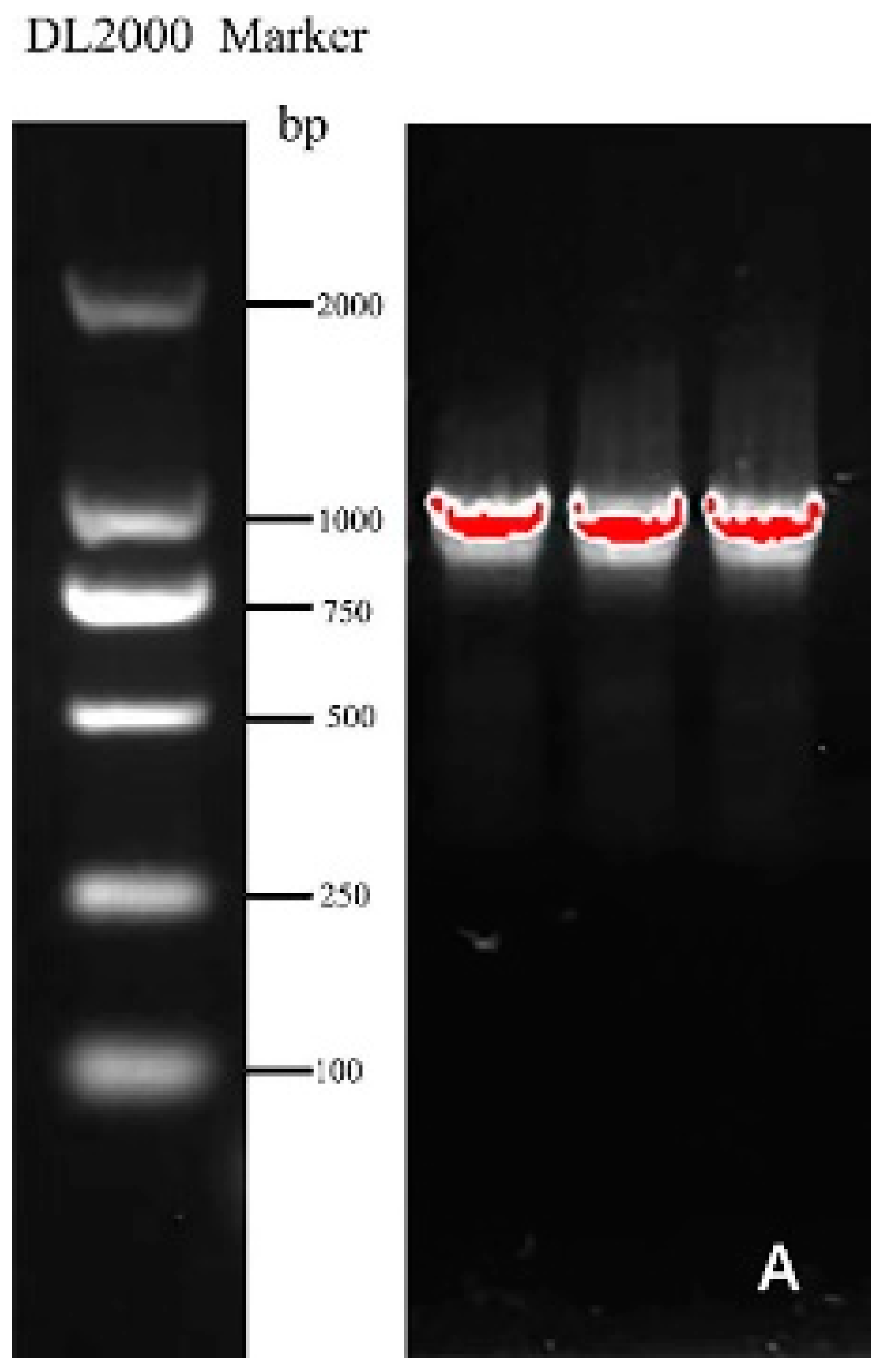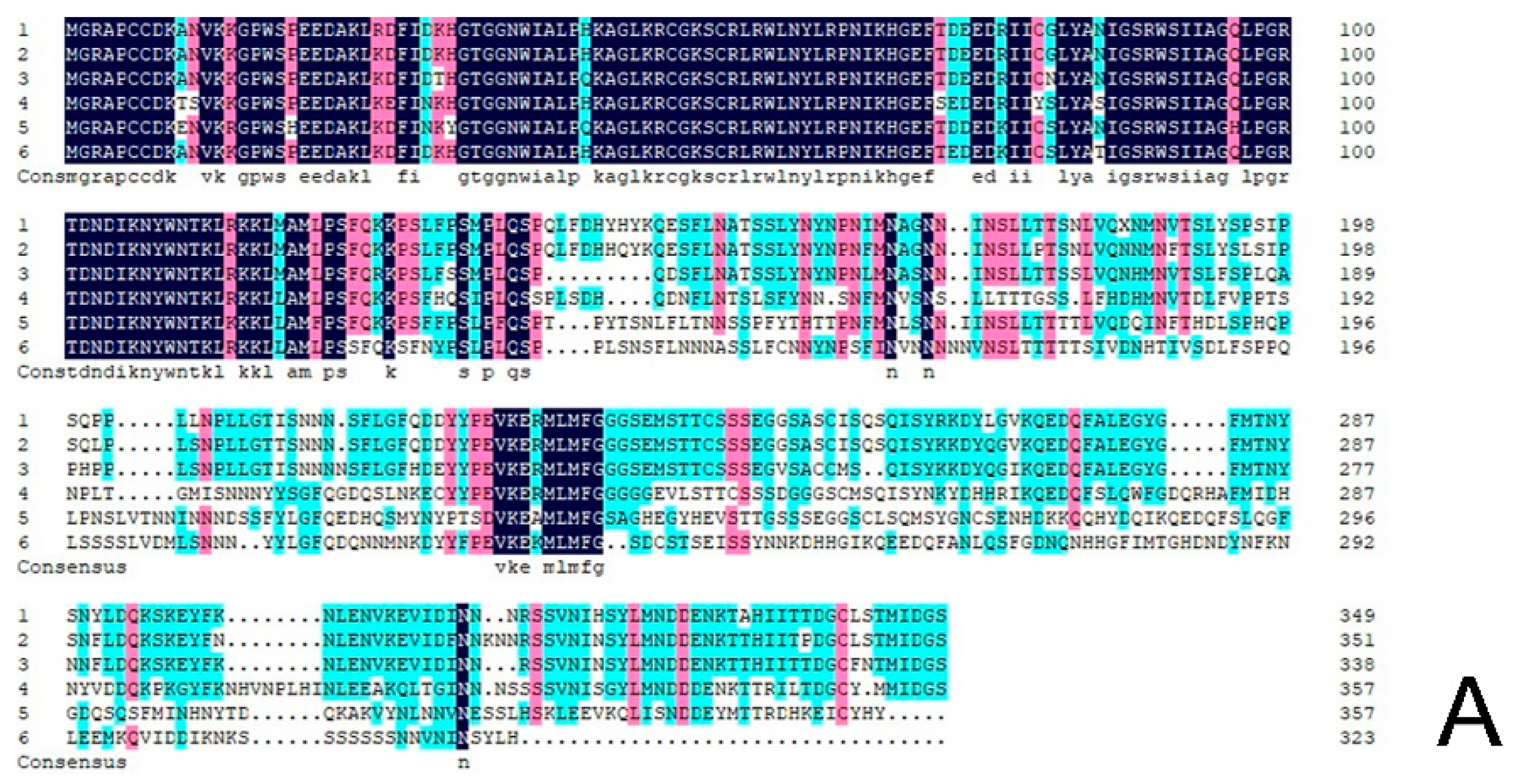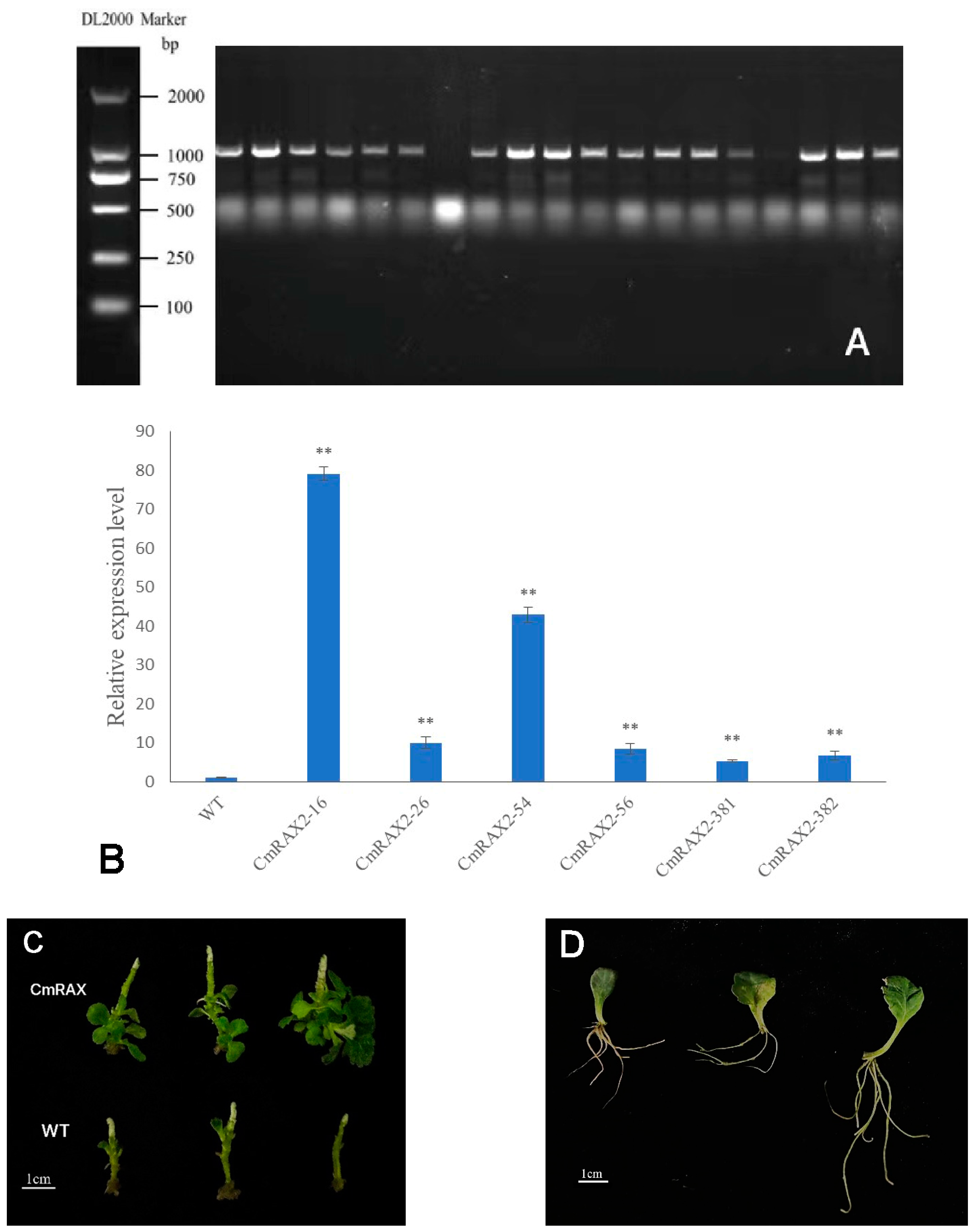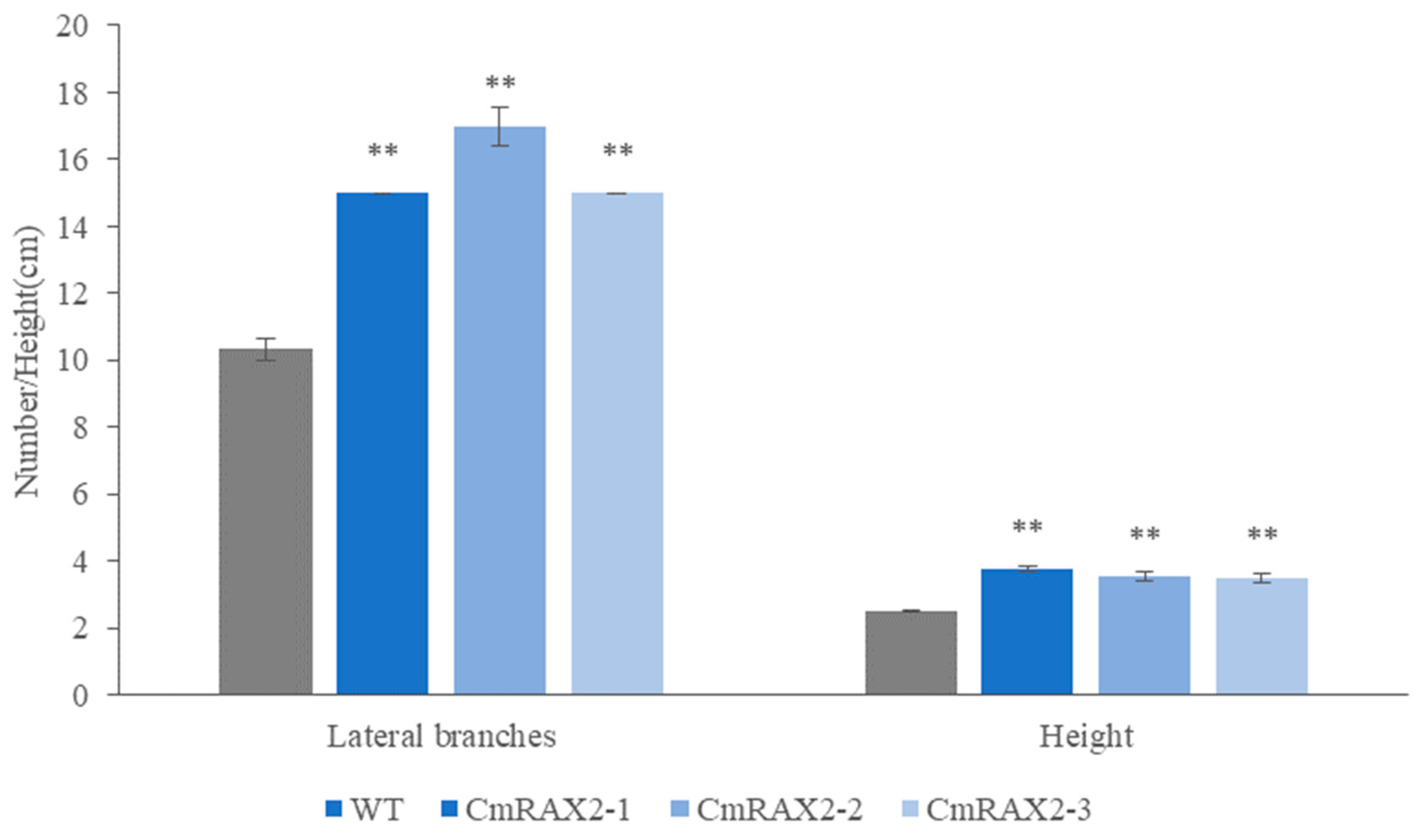Cloning and Functional Verification of CmRAX2 Gene Associated with Chrysanthemum Lateral Branches Development
Abstract
:1. Introduction
2. Materials and Methods
2.1. Plant Materials and Cultivation Conditions
2.2. Gene Cloning and Sequence Analysis
2.3. Subcellular Localization of CmRAX2
2.4. Analysis of the Transcriptional Activation Activity of CmRAX2
2.5. Quantitative Real-Time PCR Analysis
2.6. Construction of Expression Vector and Overexpressing CmRAX2 in the ‘Jinba’
3. Results
3.1. Isolation and Sequence Analysis of CmRAX2 from ‘Jinba’
3.2. Sequences Alignment and Phylogenetic Analysis of CmRAX2
3.3. Subcellular Localization of CmRAX2
3.4. Analysis of the Transcriptional Activity of CmRAX2
3.5. Expression Level Analysis of CmRAX2 in ‘Jinba’
3.6. Genetic Transformation of CmRAX2 Gene in ‘Jinba’
4. Discussion
4.1. CmRAX2 Is Expressed in the Nucleus and Cytoplasm as a Transcriptional Activator
4.2. RAX2 Expression Patterns Vary in Different Plants
4.3. RAX Plays a Role in Promoting the Development of Lateral Bud
5. Conclusions
Supplementary Materials
Author Contributions
Funding
Institutional Review Board Statement
Informed Consent Statement
Data Availability Statement
Conflicts of Interest
References
- Jiang, B.B.; Miao, H.B.; Chen, S.M.; Zhang, S.M.; Chen, F.D.; Fang, W.M. The Lateral Suppressor-Like Gene, DgLsL, Alternated the Axillary Branching in Transgenic Chrysanthemum (Chrysanthemum × morifolium) by Modulating IAA and GA Content. Plant Mol. Biol. Rep. 2010, 28, 144–151. [Google Scholar] [CrossRef]
- Wen, C.; Liu, M.J.; Shi, J.T.; Zhao, L.J. Research progress on formation and regulation of chrysanthemum laterals. J. China Agric. Univ. 2017, 22, 45–52. [Google Scholar]
- Chen, Y.Q. Cloning and Functional Analysis of Genes Related to the Development of Tobacco Axillary Buds; Chinese Academy of Agricultural Sciences: Beijing, China, 2015. [Google Scholar]
- Zuo, R.; Xu, M.L.; Chai, G.H.; Zhou, G.K. Research progress on the function and regulatory mechanism of plant MYB transcription factors. Bioscience 2012, 24, 1133–1140. [Google Scholar]
- Guo, H.G.; Wu, F.H. Research progress on the function and regulation of MYB transcription factors. Anhui Agric. Sci. 2012, 40, 10381–10383+10516. [Google Scholar]
- Ogata, K.; Kanei-Ishii, C.; Sasaki, M.; Hatanaka, H.; Nagadoi, A.; Enari, M.; Nakamura, H.; Nishimura, Y.; Ishii, S.; Sarai, A. The cavity in the hydrophobic core of Myb DNA-binding domain is reserved for DNA recognition and trans-activation. Nat. Struct. Mol. Biol. 1996, 3, 178–187. [Google Scholar] [CrossRef]
- Liu, S.M.; Sun, Y.Q.; Wang, H.Z. Plant MYB transcription factor study. J. Hangzhou Norm. Univ. (Nat. Sci. Ed.) 2012, 11, 146–150. [Google Scholar]
- Stracke, R.; Werber, M.; Weisshaar, B. The R2R3-MYB gene family in Arabidopsis thaliana. Curr. Opin. Plant Biol. 2001, 4, 447–456. [Google Scholar] [CrossRef]
- Dubos, C.; Stracke, R.; Grotewold, E.; Weisshaar, B.; Martin, C.; Lepiniec, L. MYB Transcription Factors in Arabidopsis. Trends Pant Sci. 2010, 15, 573–581. [Google Scholar] [CrossRef]
- Manghwar, H.; Hussain, A.; Ali, Q.; Liu, F. Brassinosteroids (BRs) Role in Plant Development and Coping with Different Stresses. Int. J. Mol. Sci. 2022, 23, 1012. [Google Scholar] [CrossRef]
- Manghwar, H.; Hussain, A.; Ali, Q.; Saleem, M.H.; Abualreesh, M.H.; Alatawi, A.; Ali, S.; Munis, M.F.H. Disease Severity, Resistance Analysis, and Expression Profiling of Pathogenesis-Related Protein Genes after the Inoculation of Fusarium equiseti in Wheat. Agronomy 2021, 11, 2124. [Google Scholar] [CrossRef]
- Pesch, M.; Hülskamp, M. One, two, three… models for trichome patterningin Arabidopsis. Curr. Opin. Plant Biol. 2009, 12, 587–592. [Google Scholar] [CrossRef]
- Marissa, S.; Lee, M.M.; Lin, Y.; Gish, L.; Schiefelbein, J. Distinct and overlapping roles of single-repeat MYB genes in root epidermal patterning. Dev. Biol. 2007, 311, 566–578. [Google Scholar] [CrossRef] [PubMed]
- Dubos, C.; Gourrierec, J.L.; Baudry, A.; Huep, G.; Lanet, E.; Debeaujon, I.; Routaboul, J.M.; Alboresi, A.; Weisshaar, B.; Lepiniec, L. MYBL2 is a new regulator of flavonoid biosynthesis in Arabidopsis thaliana. Plant J. 2008, 55, 940–953. [Google Scholar] [CrossRef] [PubMed]
- Matsui, K.; Umemura, Y.; Ohme-Takagi, M. At MYBL2, a protein with a single MYB domain, acts as a negative regulator of anthocyanin biosyn-thesis in Arabidopsis. Plant J. 2008, 55, 954–967. [Google Scholar] [CrossRef] [PubMed]
- Matus, J.T.; Aquea, F.; Arce-Johnson, P. Analysis of the grape MYB R2R3 subfamily reveals expanded wine quality-related clades and conserved gene structure organization across Vitis and Arabidopsis genomes. BMC Plant Biol. 2008, 8, 83. [Google Scholar] [CrossRef] [PubMed] [Green Version]
- Qi, T.C.; Huang, H.; Song, S.S.; Xie, D.X. Regulation of jasmonate mediated stamen development and seed production by a bHLH-MYB complex in Arabidopsis. Plant Cell 2015, 27, 1620–1633. [Google Scholar] [CrossRef] [Green Version]
- Millar, A.A.; Gubler, F. The Arabidopsis GAMYB-like genes, MYB33 and MYB65, are microRNA-regulated genes that redundantly facilitate anther development. Plant Cell 2005, 17, 705–721. [Google Scholar] [CrossRef] [Green Version]
- Zhu, J.; Chen, H.; Li, H.; Gao, J.F.; Jiang, H.; Wang, C.; Guan, Y.F.; Yang, Z.N. Defective in tapetal development and function 1 is essential for anther development and tapetal function for microspore maturation in Arabidopsis. Plant J. 2008, 55, 266–277. [Google Scholar] [CrossRef]
- Zhu, J.; Lou, Y.; Xu, X.F.; Yang, Z.N. A genetic pathway for tapetum development and function in Arabidopsis. J. Integr. Plant Biol. 2011, 53, 892–900. [Google Scholar] [CrossRef]
- Zhang, H.; Liang, W.Q.; Yang, X.J.; Luo, X.; Jiang, N.; Ma, H.; Zhang, D.B. Carbon starved anther encodes a MYB domain protein that regulates sugar partitioning required for rice pollen development. Plant Cell 2010, 22, 672–689. [Google Scholar] [CrossRef] [Green Version]
- Shen, X.P.; Hu, Z.W.; Xiang, X.; Xu, L.A.; Cao, J.S. Overexpression of a stamen-specific R2R3-MYB gene BcMF28 causes aberrant stamen development in transgenic Arabidopsis. Biochem. Biophys. Res. Commun. 2019, 518, 726–731. [Google Scholar] [CrossRef] [PubMed]
- Hu, R.L.; Yuan, C.; Niu, Y.; Tang, Q.L.; Wei, D.Y.; Wang, Z.M. Regulatory role of MYB transcription factors in anther development. Chin. J. Bioeng. 2020, 36, 2277–2286. [Google Scholar]
- Liu, Z.H.; Bao, W.J.; Liang, W.Q.; Yin, J.Y.; Zhang, D.B. Identification of gamyb-4 and analysis of the regulatory role of GAMYB in rice anther development. J. Integr. Plant Biol. 2010, 52, 670–678. [Google Scholar] [CrossRef]
- Sun, B.M.; Zhu, Z.S.; Chen, C.J.; Cao, B.H.; Chen, G.J.; Chen, C.M.; Lei, J.J. A jasmonate-inducible R2R3-MYB transcription factor regulates capsaicinoid biosynthesis and stamen development in Capsicum. J. Agric. Food Chem. 2019, 67, 10891–10903. [Google Scholar] [CrossRef] [PubMed]
- Rahim, M.A.; Resentini, F.; Vecchia, F.D.; Trainotti, L. Effects on Plant Growth and Reproduction of a Peach R2R3-MYB Transcription Factor Overexpressed in Tobacco. Front. Plant Sci. 2019, 10, 1143. [Google Scholar] [CrossRef] [PubMed]
- Lee, D.-K.; Geisler, M.; Springer, P.S. LATERAL ORGAN FUSION1 and LATERAL ORGAN FUSION2 function in lateral organ separation and axillary meristem formation in Arabidopsis. Development 2009, 136, 2423–2432. [Google Scholar] [CrossRef] [Green Version]
- Yang, H.; Xue, Q.; Zhang, Z.Z.; Du, J.Y.; Yu, D.Y.; Huang, F. GmMYB181, a Soybean R2R3-MYB Protein, Increases Branch Number in Transgenic Arabidopsis. Front. Plant Sci. 2018, 9, 1027. [Google Scholar] [CrossRef]
- Keller, T.; Abbott, J.; Moritz, T.; Doerner, P. Arabidops is REGULATOR OF AXILLARY MERISTEMS1 Controls a Leaf Axil Stem Cell Niche and Modulates Vegetative Development. Plant Cell 2006, 18, 598–611. [Google Scholar] [CrossRef] [Green Version]
- Müller, D.; Schmitz, G.; Theres, K. Blind Homologous R2R3 Myb Genes Control the Pattern of Lateral Meristem Initiation in Arabidopsis. Plant Cell 2006, 18, 586–597. [Google Scholar] [CrossRef] [Green Version]
- Greb, T.; Clarenz, O.; Schafer, E.; Muller, D.; Herrero, R.; Schmitz, G.; Theres, K. Molecular analysis of the LATERAL SUPPRESSOR gene in Arabidopsis reveals a conserved control mechanism for axillary meristem formation. Genes Dev. 2003, 17, 1175–1187. [Google Scholar] [CrossRef] [Green Version]
- Jia, T.Q.; Zhang, K.D.; Li, F.; Huang, Y.F.; Fan, M.M.; Huang, T. The AtMYB2 inhibits the formation of axillary meristem in Arabidopsis by repressing RAX1 gene under environmental stresses. Plant Cell Rep. 2020, 39, 1755–1765. [Google Scholar] [CrossRef] [PubMed]
- Xiong, F. Cloning and Expression Analysis of PhRAX2 and PhRAX3 Genes in Petunia; Anhui Agricultural University: Hefei, China, 2019. [Google Scholar]
- Saitou, N.; Nei, M. The neighbor-joining method: A new method for reconstructing phylogenetic trees. Mol. Biol. Evol. 1987, 4, 406–425. [Google Scholar] [PubMed]
- Kumar, S.; Stecher, G.; Li, M.; Knyaz, C.; Tamura, K. MEGA X: Molecular Evolutionary Genetics Analysis across Computing Platforms. Mol. Biol. Evol. 2018, 35, 1547–1549. [Google Scholar] [CrossRef] [PubMed]
- Naeem, M.; Shahzad, K.; Saqib, S.; Shahzad, A.; Nasrullah; Younas, M.; Afridi, M.I. The Solanum melongena COP1LIKE manipulates fruit ripening and flowering time in tomato (Solanum lycopersicum). Plant Growth Regul. 2022, 96, 369–382. [Google Scholar] [CrossRef]
- Sun, X.; Wang, X.F.; Zheng, C.S.; Xing, S.Y.; Shu, H.R. The cDNA Cloning and Analysis of Sequence Information and Quantitative Express of Chrysanthemum Rhythms Clock Output Gene CmGI(GIGANTEA). Sci. Agric. Sin. 2012, 45, 2690–2703. [Google Scholar]
- Ayaz, A.; Huang, H.; Zheng, M.; Zaman, W.; Li, D.; Saqib, S.; Zhao, H.; Lü, S. Molecular Cloning and Functional Analysis of GmLACS2-3 Reveals Its Involvement in Cutin and Suberin Biosynthesis along with Abiotic Stress Tolerance. Int. J. Mol. Sci. 2021, 22, 9175. [Google Scholar] [CrossRef]
- Wang, W.; Wang, X.; Wang, X.; Ahmed, S.; Hussain, S.; Zhang, N.; Ma, Y.; Wang, S. Integration of RACK1 and ethylene signaling regulates plant growth and development in Arabidopsis. Plant Sci. 2019, 280, 31–40. [Google Scholar] [CrossRef]
- Yin, R.; Skvortsova, M.Y.; Loubéry, S.; Ulm, R. COP1 is required for UV-B–induced nuclear accumulation of the UVR8 photoreceptor. Proc. Natl. Acad. Sci. USA 2016, 113, E4415–E4422. [Google Scholar] [CrossRef] [Green Version]
- Lau, O.S.; Deng, X.W. The photomorphogenic repressors COP1 and DET1: 20 years later. Trends Plant Sci. 2012, 7, 584–593. [Google Scholar] [CrossRef]
- Brown, B.A.; Cloix, C.; Jiang, G.H.; Kaiserli, E.; Herzyk, P.; Kliebenstein, D.J.; Jenkins, G.I. A UV-B-specific signaling component orchestrates plant UV protection. Proc. Natl. Acad. Sci. USA 2005, 102, 18225–18230. [Google Scholar] [CrossRef] [Green Version]
- Huang, X.; Zhang, Q.; Jiang, Y.P.; Yang, C.W.; Wang, Q.Y.; Li, L. Shade-induced nuclear localization of PIF7 is regulated by phosphorylation and 14-3-3 proteins in Arabidopsis. eLife 2018, 7, e31636. [Google Scholar] [CrossRef] [PubMed]
- Wang, W.F. Transcriptomic Analysis of Topping-Induced Axillary Shoots Outgrowth and Functional Research of Related Genes in Tobacco; Chinese Academy of Agricultural Sciences: Beijing, China, 2019. [Google Scholar]
- Wang, S. Isolation and Functional Analysis of the BpCUC2 Gene and Its Promoter in Betula Pendula; Northeast Forestry University: Harbin, China, 2015. [Google Scholar]
- Franco, D.M.; Hernández, N.B.; Maldonado, W.M. Characterization of the labor skills of the graduates of Psychology Program at the University of Costa CUC. Psychol. Thesis Mag. Fac. Psychol. 2016, 17, 216–235. [Google Scholar]
- Wu, J.S.; Zhao, Y.H.; Wang, X.S. Bioinformatics analysis of the MYB protein family in japonica rice. J. S. China Agric. Univ. 2009, 30, 43–47. [Google Scholar]
- Stracke, R.; Ishihara, H.; Huep, G.; Barsch, A.; Mehrtens, F.; Niehaus, K.; Weisshaar, B. Differential regulation of closely related R2R3-MYB transcription factors controls flavonol accumu-lation in different parts of the Arabidopsis thaliana seedling. Plant J. 2007, 50, 660–677. [Google Scholar] [CrossRef] [Green Version]










| Gene | Primers |
|---|---|
| CmRAX2-F | ATGGGAAGAGCTCCTTGTTG |
| CmRAX2-R | ATTACTCCCATCAATCATAG |
| 35S-F | GACGCACAATCCCACTATCC |
| qRT–PCR CmRAX2-F | TGGTACTGGTGGTAACTGGATTGC |
| qRT–PCR CmRAX2-R | AGCCATCTCAACCTGCAACTCTTG |
| qRT–PCR Actin-F | ACAACTGCTGAACGGGAAAT |
| qRT–PCR Actin -R | AATCATAGACGGCTGGAAAAG |
Publisher’s Note: MDPI stays neutral with regard to jurisdictional claims in published maps and institutional affiliations. |
© 2022 by the authors. Licensee MDPI, Basel, Switzerland. This article is an open access article distributed under the terms and conditions of the Creative Commons Attribution (CC BY) license (https://creativecommons.org/licenses/by/4.0/).
Share and Cite
Song, J.; Chen, Y.; Li, X.; Ma, Q.; Liu, Q.; Pan, Y.; Jiang, B. Cloning and Functional Verification of CmRAX2 Gene Associated with Chrysanthemum Lateral Branches Development. Genes 2022, 13, 779. https://doi.org/10.3390/genes13050779
Song J, Chen Y, Li X, Ma Q, Liu Q, Pan Y, Jiang B. Cloning and Functional Verification of CmRAX2 Gene Associated with Chrysanthemum Lateral Branches Development. Genes. 2022; 13(5):779. https://doi.org/10.3390/genes13050779
Chicago/Turabian StyleSong, Jingjing, Yijun Chen, Xin Li, Qiqi Ma, Qinglin Liu, Yuanzhi Pan, and Beibei Jiang. 2022. "Cloning and Functional Verification of CmRAX2 Gene Associated with Chrysanthemum Lateral Branches Development" Genes 13, no. 5: 779. https://doi.org/10.3390/genes13050779
APA StyleSong, J., Chen, Y., Li, X., Ma, Q., Liu, Q., Pan, Y., & Jiang, B. (2022). Cloning and Functional Verification of CmRAX2 Gene Associated with Chrysanthemum Lateral Branches Development. Genes, 13(5), 779. https://doi.org/10.3390/genes13050779






